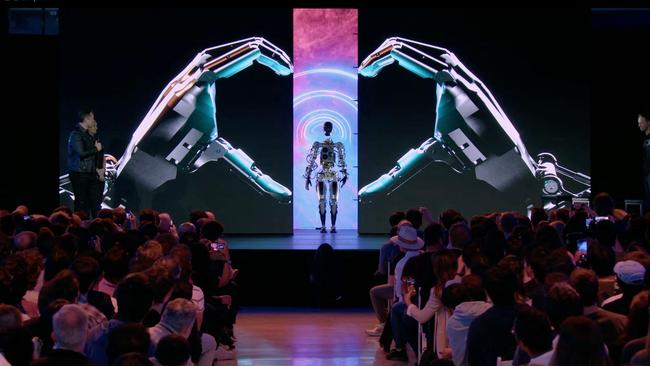Elon Musk says there will be more humanoid robots than people by 2040, but Amazon isn’t so sure
The tech leader thinks robots will catapult Tesla to becoming a $US25 trillion company. But Amazon’s robotics boss says it ‘starts verging into creepy’.

Elon Musk says there will be billions of humanoid robots — more than earth’s population — in the next 20 years, catapulting Tesla to become a $US25 trillion ($38.12 trillion) company.
But, his bold claim has put him at odds with one the biggest investors in robotics: Amazon.
Amazon says it “ushered in a new age of robotics” when it acquired Massachusetts-based Kiva Systems for $SU775m in 2012.
The $US2.08 trillion eCommerce-titan now has more than 750,000 robots working alongside its staff at its fulfilment centres across the globe. But, many are named after birds and don’t look anything like humans.
Mikell Taylor, the head of Amazon’s autonomous robotics program, doesn’t even like robots to have eyes (she was overruled on Amazon’s first “social robot” Proteus, but it looks more like a robotic vacuum cleaner than a human).
“Largely because of sci-fi, people want to put eyes on robots because they want them kind of anthropomorphised and personified and there’s not a lot of thought that goes into, ‘what are those eyes for? Why are they there? What are they doing? What’s their purpose?’ And so you kind of get these robots that look cute, but it’s a little bit meaningless, and sometimes it starts verging into creepy,” Ms Taylor said.

Ms Taylor has also said when robots are designed to resemble humans “you tend to ascribe to it the capabilities of the human and therefore also the responsibilities of a human”.
Most of Amazon’s robots are therefore designed to perform specific tasks and prevent injuries across its human workforce. For example, its Cardinal robot — named after the mid-sized songbird — is a robotic arm which uses advanced AI and computer vision to quickly select one package out of a pile of packages delivered via a chute, lift it with air suction, read the label, and precisely place it into the appropriate cart before it’s brought to a truck in the loading dock.
This differs to Mr Musk’s smart robot at Tesla, dubbed Optimus, which looks like a human. It is designed to be a general purpose robot, capable of performing unsafe, repetitive or boring tasks.
Mr Musk told the 8th Future Investment Initiative conference in Riyadh, Saudi Arabia, last week he expects there to be at least 10 billion humanoid robots — priced between $US20,000 and $US25,000 — deployed by 2040.
“Robotic taxis makes Tesla about a $US5 trillion company,” Mr Musk said. “The Optimus Robot, I think, makes Tesla a $US25 trillion company.” Tesla currently has a market value of $US780.17bn.

In 2022, during pandemic-fuelled labour shortages, Mr Musk was talking up the potential of humanoid robots.
“If you think about the economy, the foundation of the economy is labour. Capital equipment is the skilled labour,” Mr Musk said during an investor call. “So what happens if you don’t actually have a labour shortage? I’m not sure what kind of an economy (it) even means at that point. That’s what Optimus is about.”
He said he plans to use the robots first in roles such as “moving parts around the factory”, saying “If we can’t find a use for it, we should not expect that others would.”

Amazon has tested a bipedal robot dubbed “Digit” as part of its partnership with Agility Robotics. But, Amazon Robotics vice president Scott Dresser said last year the company wasn’t rushing into building human-like machines.
It has since introduced Proteus to some of its fulfilment centres in the US. I doesn’t need to be locked behind a cage, working alongside staff while carrying around heavy carts of parcels. It has two eyes — despite Ms Taylor’s objection — but staff wanted to have some way to connect with the machine.
For example if an employee gets in the way of a Proteus robot, it stops, makes a sound and looks at the employee. As one Amazon worker said “if you get in their way they will squeal and give you the side eye”.
“Early with the Proteus product, we were able to determine that actually eyes were the right answer here,” Ms Taylor concedes.
“We learned how the employees working around the robots use them, how they respond to them and we’ve iterated on that to make sure that they are useful, are meaningful and have a purpose.”






To join the conversation, please log in. Don't have an account? Register
Join the conversation, you are commenting as Logout